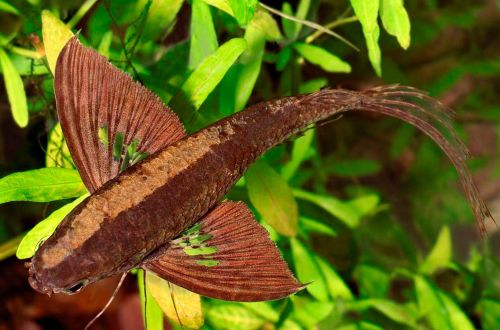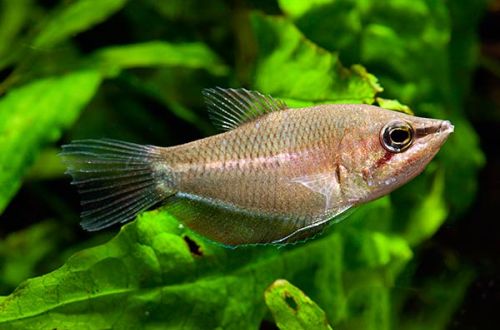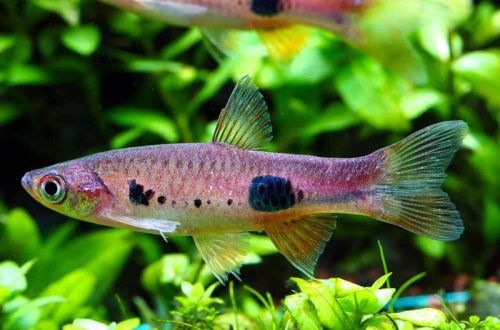
Butterfly fish
The African Butterflyfish or Pantodon, scientific name Pantodon buchholzi, belongs to the Pantodontidae family. It has an unusual appearance. Friendly disposition and low maintenance make this fish an excellent choice for aquarists looking for “something special”. Despite their sedentary lifestyle, this species is famous for its rapid jumps from the water for several meters, so make sure you have a reliable and safe cover for the tank in advance.

Contents
Habitat
It comes from the regions of West Africa from the territory of such modern states as the Republic of the Congo, the Central African Republic, Chad, Nigeria, Sierra Leone, Niger, Gabon, etc. It lives throughout the Congo River basin in numerous lakes, swamps and whirlpools of small rivers and streams characterized by dense aquatic vegetation and numerous snags.
Brief information:
- The volume of the aquarium – from 80 liters.
- Temperature – 23-30°C
- Value pH — 6.0–7.5
- Water hardness – soft to hard (5-15 dGH)
- Substrate type – any
- Lighting – subdued
- Brackish water – no
- Water movement – no
- The size of the fish is up to 12 cm.
- Food – meat
- Temperament – peaceful, little active
- A twilight lifestyle is led, keeps near the surface
Description
The appearance of the fish is quite unusual. When viewed from above, it becomes clear where the name “African Butterflyfish” came from. Enlarged pectoral fins, more like wings, have two main purposes – camouflage and jumping. On duty, floating on the surface, the fish can be mistaken for a dry fallen leaf, but if necessary, with a sharp movement of a wide tail, it is able to jump out of the water for a decent distance, for example, to catch a flying insect or escape from a predator.
Adults reach a length of about 12 cm, although due to the large fins and tail, the dimensions appear larger. The main color is gray with dark pigmentation throughout the body. The rays of the fins resemble dotted lines.
Food
Accepts exclusively meat products in live and frozen form. At home, you can serve bloodworms, brine shrimp, small worms, various flying insects of a suitable size (flies, mosquitoes). It feeds exclusively near the surface, so all food that has fallen to the bottom will be ignored.
Maintenance and care, arrangement of the aquarium
The dimensions of the tank directly depend on the number of inhabitants, with a single or paired content, the recommended volume of the aquarium starts from 80 liters. The design of the lower tier is arbitrary, for example, a dark substrate with driftwood everywhere. The surface area should contain some floating plants, do not allow overgrowth to fill. Open water must be at least half of the total surface area.
Water conditions have a slightly acidic pH value and low carbonate hardness. It is possible to add a few pre-dried leaves, which, in the process of decomposition, will saturate the water with tannins and give it a tea shade. Leaves are replaced every two weeks or more often.
Any movement of water must be kept to a minimum, which limits the choice of filters. Consult with a specialist beforehand and select the type of device that combines good performance, but does not create an internal flow. The minimum set of equipment also includes a heater, an aerator and a lighting system.
Aquarium maintenance comes down to weekly replacement of part of the water (15–20% of the volume) with fresh water, periodic cleaning of the soil from organic waste and glass from plaque.
Behavior and Compatibility
Leads a twilight lifestyle, sedentary, except when hunting for surface insects or escaping from predators. Butterflyfish are considered to be quite peaceful, but can be aggressive towards other species living near the surface, in addition, any small fish that can fit in their mouth will soon be eaten. Incompatible with fish, such as Barbs, which are prone to biting off the wide fins of their neighbors.
Breeding / breeding
At home, breeding is problematic, but possible. If representatives of other species live in the aquarium, then spawning should be carried out in a separate tank, which is filled with water from the main aquarium. In the design, clusters of floating shade-loving plants are used, any soil can be used without it. The equipment includes a simple foam airlift filter and a heater. The amount of light coming from the room will be sufficient.
A couple of fish are placed in a prepared tank. Within 3 weeks, the water level is gradually lowered, by the end of the period about half of the total volume should remain. By this time, the hydrochemical composition is brought to a slightly acidic pH value, and temperatures to 26–28°C. Then, during 2-3 days, cool water is added in portions, the temperature drops to 23 ° C. Such actions imitate natural conditions when the dry period is replaced by the rainy season.
At the last stage, spawning occurs, the female releases up to 100 eggs per day for several days. They are lighter than water and immediately float to the surface. Parental instincts are poorly developed, so the eggs should be removed to a separate temporary container so that the fish do not eat them. At the end of spawning, the eggs and newly-born parents are returned to their places.
The fry appear on the 3rd-4th day and are able to take only live microscopic food, and they do not swim in search of food, so you will have to bury food directly in front of them with a pipette. Feeding the juveniles is the main problem in breeding the African Butterflyfish.
Fish diseases
A balanced diet and suitable living conditions are the best guarantee against the occurrence of diseases in freshwater fish, so if the first symptoms of an illness appear (discoloration, behavior), the first thing to do is check the condition and quality of the water, if necessary, return all values to normal, and only then do treatment. Read more about symptoms and treatments in the Aquarium Fish Diseases section.





